![]()
![]()
![]()
Use LEFT and RIGHT arrow keys to navigate between flashcards;
Use UP and DOWN arrow keys to flip the card;
H to show hint;
A reads text to speech;
41 Cards in this Set
- Front
- Back
- 3rd side (hint)
|
Features that are shared by all animals
|
Multicellular
heterotrophic, eukaryotes, tissues develop from embryonic layers |
|
|
|
define tissues
|
groups of similar cells that act as a functional unit
|
|
|
|
Most animals have a ___________ stage in life, not humans.
|
larval, a sexually immature form of an animal that morphologically distinct from the adult. these usually undergo a metamorphosis.
|
|
|
|
List the stages of early embryonic development
|
1. The zygote of the animals undergoes a series of mitosis cell divisions called a cleavage.
2. An eight cell embryo is formed. 3. in most animals, the cleavage produces a multicellular stage called a blastula. 4. Most undergo a gastrulation where it folds in itself and makes a blastocoel 5. The blastocoel opens to the outside with a blastopore. 6. The endoderm develops. |
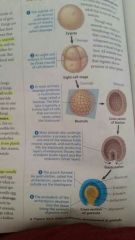
|
|
|
layers of a gastrula
|
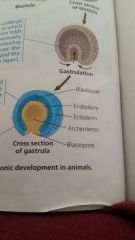
|
|
|
|
the closest living relative of animals and why we believe that
|
Chanoflagelletes
1. DNA sequence data indicate they are sister groups 2. Similar collar cells have been identified in other animals like cnidarians flatworms and echinoderms. 3. Morphologically cola cells are identical to sponge collar cells |
|
|
|
hox genes are known for
|
development of animals embryo
|
|
|
|
What was the Cambrian explosion and when was it?
|
During the Paleozoic era, the Cambrian explosion was a wave of animal diversification around 535-525 million years ago.
|
|
|
|
Why is the Cambrian explosion significant?
|
Paleontologists have found about half of all extant animal phyla, including arthropods, chordates, and echinoderms. Also most of the fossils are bilaterians.
|
|
|
|
What are some theories for why the Cambrian explosion occurred?
|
1. Predators acquired new adaptations while prey had to find new defenses, this could force Natural selection which would have lead to a decline of soft bodied Edicarian species.
2. An increase in atmospheric oxygen. More oxygen would have favored animals with higher metabolic rates, while potentially harming others. 3. A genetic change, like the development of hox genes and the new addition of microRNA facilitated evolution. |
|
|
|
When is the Cenozoic era and what are some markers for it?
|
65.5 million years ago to Present
Ushered in after the mass extinctions of marine and terrestial animals. There has been a rise in large mammalian herbivores and the global climate gradually cooled. |
|
|
|
What are body plans and give an example
|
A particular set of morphological and developmental traits. Some examples would be symmetry, tissues, body cavities, and protosome/deutrosome development
|
|
|
|
Types of Symmetry and an example
|
Asymmetrical - lack of symmetry like a sponge
Radial Symmetry- animals that have a top and bottom side but no front or back, can be cut through center anywhere and be symmetrical. Like a sea anemone. Bilateral symmetry - Has a front and back and a top and bottom like a lobster |
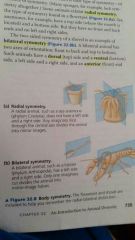
|
|
|
Germ Layers
|
Tissue layers that develop during the layering in gastrulation and form the various organs and tissues in the body. Note sponges lack these as they do not have true tissue.
|
|
|
|
Ectoderm
|
The germ layer covering the surface of the embryo. This gives rise to the outer covering of animal. and in some the nervous system.
|
|
|
|
Endoderm
|
the innermost germ layer. lines the pouch that during gastrulation and gives rise to the linings of the digestive tract and organs such as the liver.
|
|
|
|
diploblastic
|
Only two germ layers. Only a few animal groups have this like cnidarians.
|
|
|
|
Mesoderm
|
A germ layer the lies between the ectoderm and the endoderm. only present in triploblastic animals
|
|
|
|
Body Cavities and functions
|
in most triploblastic animals this is a fluid or air filled space located between the digestive tract and the outer body wall.
It helps to suspend organs it enables internal organs to grow and move independently of the outer body wall. |
|
|
|
Coelomate
|
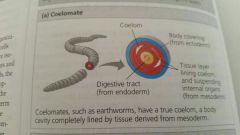
|
|
|
|
Pseudocoelomate
|
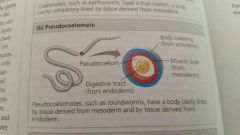
|
|
|
|
acoelomate
|
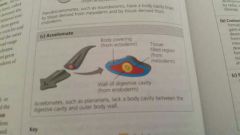
|
|
|
|
coelom formation
|
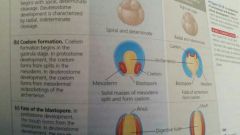
in protosome development coelom forms from splits in the mesoderm in deutrosome formation he coelom forms from the outpocketing of the archneteron
|
|
|
|
Fate of blastopore in protosome and deutrosome development
|
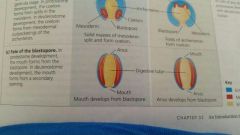
protosome mouth then anus
deutrosome anus then mouth |
|
|
|
Since animals probably evolved from colonial protists, how do they differ? |
Animals have more cells and their cells show greater specialization. |
|
|
|
During animal development, cleavage leads to _________, |
A multicellular blastula |
|
|
|
Many young animals are _____, a sexually immature form that is morphologically distinct from the adult. |
Larvae |
|
|
|
Young animals go through ______, which leads to becoming a _______, that resembles adults but is sexually immature. |
Metamorphosis Juvenile |
|
|
|
Order of embryonic stages |
Zygote, blastula, gastrula, larvae Zebras bite grass lightly |
|
|
|
The development of Hox genes occurred when? |
During the Cambrian explosion |
|
|
|
Flight evolved in pterosaurs and birds when? |
Mesozoic era |
|
|
|
Cephalizatio is generally associated with _____ |
Bilateral symmetry |
|
|
|
Ectoderm and endoderm are associated with |
Cnidarians |
|
|
|
Ectoderm gives rise to ____ mesoderm gives rise to ___ and endoderm gives rise to------ |
Central nervous system, muscle, and lining of the digestive tract |
|
|
|
Coelomate |
A body cavity lined with mesoderm |
|
|
|
Pseudocoelomate |
Lined with endoderm and mesoderm |
|
|
|
Why is the presence of a coelom advantageous? |
It allows for room for the development and movement of internal organs |
|
|
|
Indeterminate cleavage produces embryonic cells that |
Retain the capacity to develop into a new embryo |
|
|
|
The zygote of many protosome undergo ______ cleavage and ------ cleavage |
Spiral Determinate |
|
|
|
Cell fate is determined ______ during embryonic development for protosomes. |
Early |
|
|
|
The clade Ecdysozoa is named for what characteristic |
The secretion of a stiff external skeleton |
|

